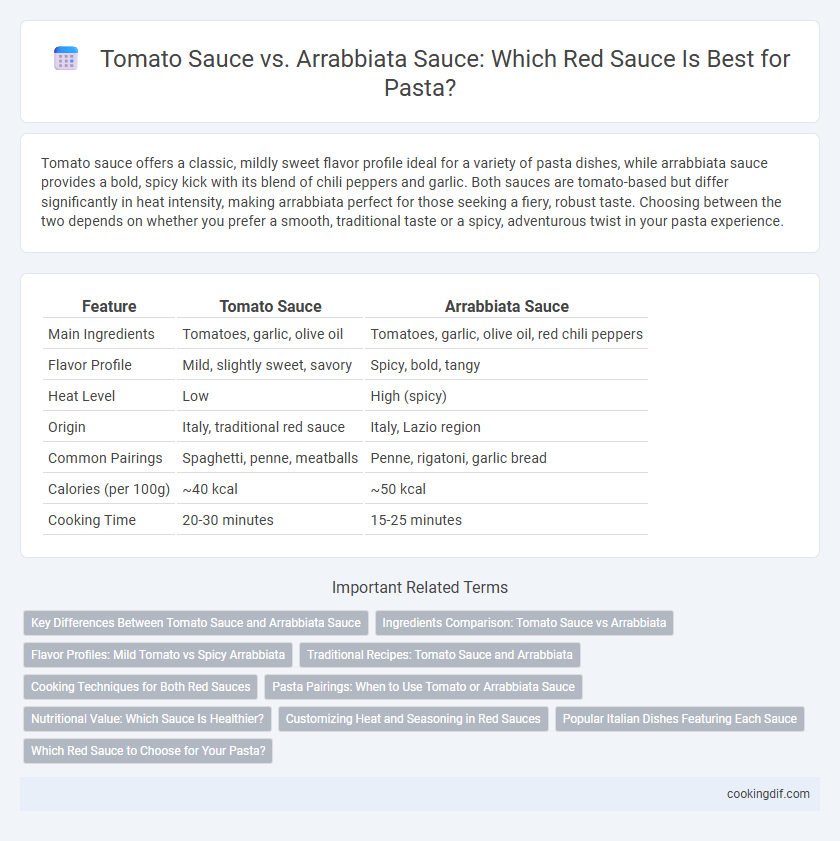Tomato sauce offers a classic, mildly sweet flavor profile ideal for a variety of pasta dishes, while arrabbiata sauce provides a bold, spicy kick with its blend of chili peppers and garlic. Both sauces are tomato-based but differ significantly in heat intensity, making arrabbiata perfect for those seeking a fiery, robust taste. Choosing between the two depends on whether you prefer a smooth, traditional taste or a spicy, adventurous twist in your pasta experience.
Table of Comparison
| Feature | Tomato Sauce | Arrabbiata Sauce |
|---|---|---|
| Main Ingredients | Tomatoes, garlic, olive oil | Tomatoes, garlic, olive oil, red chili peppers |
| Flavor Profile | Mild, slightly sweet, savory | Spicy, bold, tangy |
| Heat Level | Low | High (spicy) |
| Origin | Italy, traditional red sauce | Italy, Lazio region |
| Common Pairings | Spaghetti, penne, meatballs | Penne, rigatoni, garlic bread |
| Calories (per 100g) | ~40 kcal | ~50 kcal |
| Cooking Time | 20-30 minutes | 15-25 minutes |
Key Differences Between Tomato Sauce and Arrabbiata Sauce
Tomato sauce is a basic red sauce made from cooked tomatoes, garlic, onions, and herbs, offering a mild and versatile flavor ideal for various pasta dishes. Arrabbiata sauce is a spicy variation of tomato sauce, featuring added red chili peppers and extra garlic that create a bold, fiery taste. The key difference lies in the heat level and intensity, with arrabbiata delivering a sharp, peppery kick, while tomato sauce remains smooth and subtly sweet.
Ingredients Comparison: Tomato Sauce vs Arrabbiata
Tomato sauce primarily contains tomatoes, garlic, olive oil, and basil, resulting in a mild, sweet flavor profile. Arrabbiata sauce shares these base ingredients but incorporates red chili peppers and extra garlic, creating a spicy and bold taste. Both sauces use tomato as the foundation but differ significantly in heat level and aromatic intensity.
Flavor Profiles: Mild Tomato vs Spicy Arrabbiata
Tomato sauce offers a mild, sweet, and slightly tangy flavor profile that complements a variety of pasta dishes without overpowering other ingredients. Arrabbiata sauce, known for its bold, spicy kick, features garlic, chili peppers, and olive oil, creating a vibrant heat that enhances pasta with an intense and fiery taste. The choice between these sauces depends on preference for subtle sweetness versus a robust, spicy experience.
Traditional Recipes: Tomato Sauce and Arrabbiata
Traditional tomato sauce is a simple blend of ripe tomatoes, garlic, olive oil, and fresh basil, creating a smooth and mildly sweet flavor ideal for classic pasta dishes like spaghetti al pomodoro. Arrabbiata sauce incorporates the same base ingredients but infuses them with crushed red chili peppers, resulting in a spicy and robust taste that complements penne and other sturdy pasta shapes. Both sauces highlight the versatility of Italian red sauces, with tomato sauce emphasizing freshness and arrabbiata offering a fiery kick rooted in Roman culinary tradition.
Cooking Techniques for Both Red Sauces
Tomato sauce involves slow simmering crushed tomatoes with garlic, onions, and herbs to develop a rich, balanced flavor, often finished with a splash of olive oil for smoothness. Arrabbiata sauce requires a quick saute of garlic and dried chili peppers in olive oil before adding tomatoes, creating a spicy, vibrant sauce with a sharp heat that intensifies during brief simmering. Both sauces rely on fresh ingredients and controlled cooking times to enhance their distinctive taste profiles, with tomato sauce focusing on depth and sweetness, while arrabbiata emphasizes bold, spicy notes.
Pasta Pairings: When to Use Tomato or Arrabbiata Sauce
Tomato sauce pairs well with delicate pasta like spaghetti or penne, enhancing the dish without overpowering the subtle flavors. Arrabbiata sauce, with its spicy chili kick, complements heartier pasta such as rigatoni or fusilli, balancing rich, robust ingredients. Choosing between the two depends on desired heat level and pasta texture, ensuring an optimal flavor harmony.
Nutritional Value: Which Sauce Is Healthier?
Tomato sauce typically contains fewer calories and less sodium than arrabbiata sauce, making it a lighter option for those focused on heart health and calorie control. Arrabbiata sauce, enriched with chili peppers, offers a metabolism-boosting effect and higher vitamin C content, but its spiciness may increase digestive discomfort for sensitive individuals. Nutritionally, tomato sauce provides essential antioxidants like lycopene with minimal fat, while arrabbiata adds benefits of capsaicin but often includes more added salt and oil.
Customizing Heat and Seasoning in Red Sauces
Tomato sauce offers a mild and naturally sweet base that can be easily customized with herbs like basil and oregano to enhance its flavor without overwhelming heat. Arrabbiata sauce stands out with its bold spiciness, achieved through generous amounts of red chili peppers, perfect for those seeking a fiery kick in their pasta dishes. Adjusting the level of chili flakes or garlic in arrabbiata allows precise control over the heat and seasoning, making it a versatile option for heat lovers.
Popular Italian Dishes Featuring Each Sauce
Tomato sauce, a staple in Italian cuisine, is famously featured in dishes like classic Spaghetti al Pomodoro and lasagna, celebrated for its sweet, mellow flavor derived from ripe tomatoes and herbs. Arrabbiata sauce, known for its spicy kick from chili peppers, is a key ingredient in Penne all'Arrabbiata, delivering a bold taste favored in Roman cooking. Both sauces exemplify the diversity of Italian red sauces, catering to varying palates with their distinct flavor profiles and culinary applications.
Which Red Sauce to Choose for Your Pasta?
Tomato sauce offers a classic, mild flavor ideal for versatile pasta dishes, with its base of ripe tomatoes, garlic, and herbs like basil and oregano. Arrabbiata sauce provides a spicy alternative, combining tomatoes with red chili peppers and garlic, delivering a robust, fiery kick. Choosing between the two depends on your preference for heat intensity and the complementary flavors you want to highlight in your pasta.
Tomato sauce vs arrabbiata sauce for red sauces Infographic

 cookingdif.com
cookingdif.com